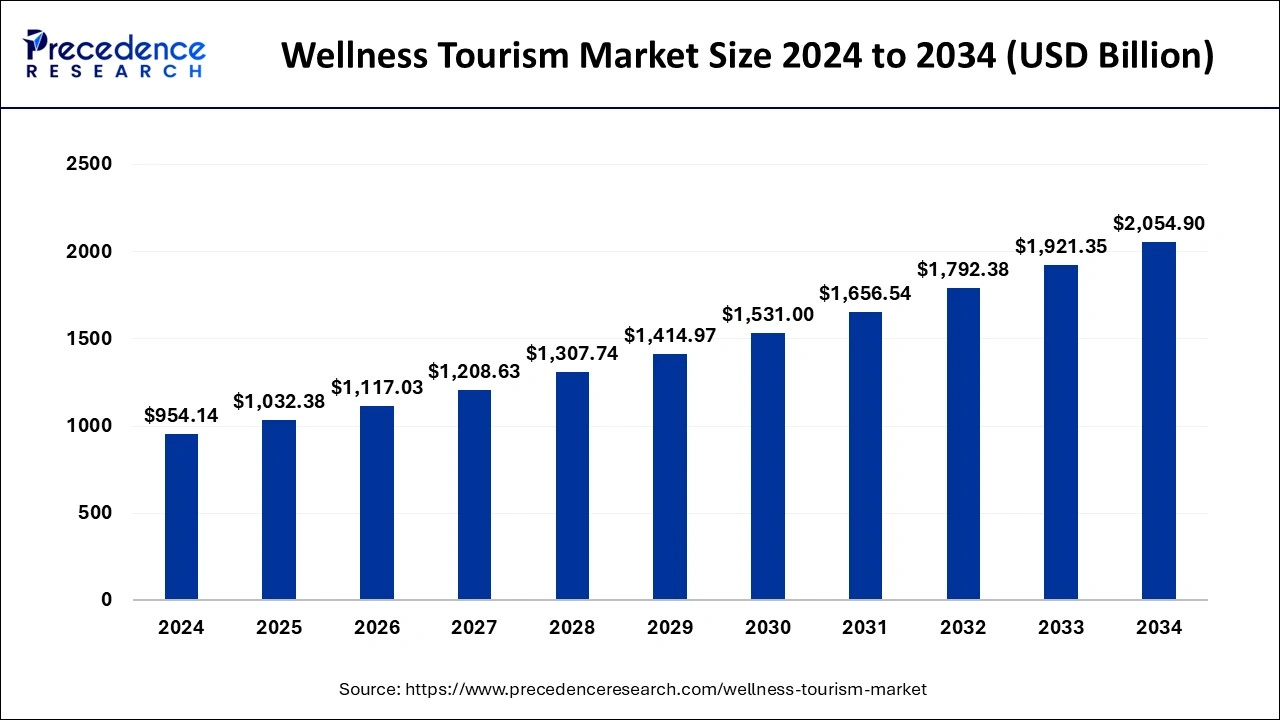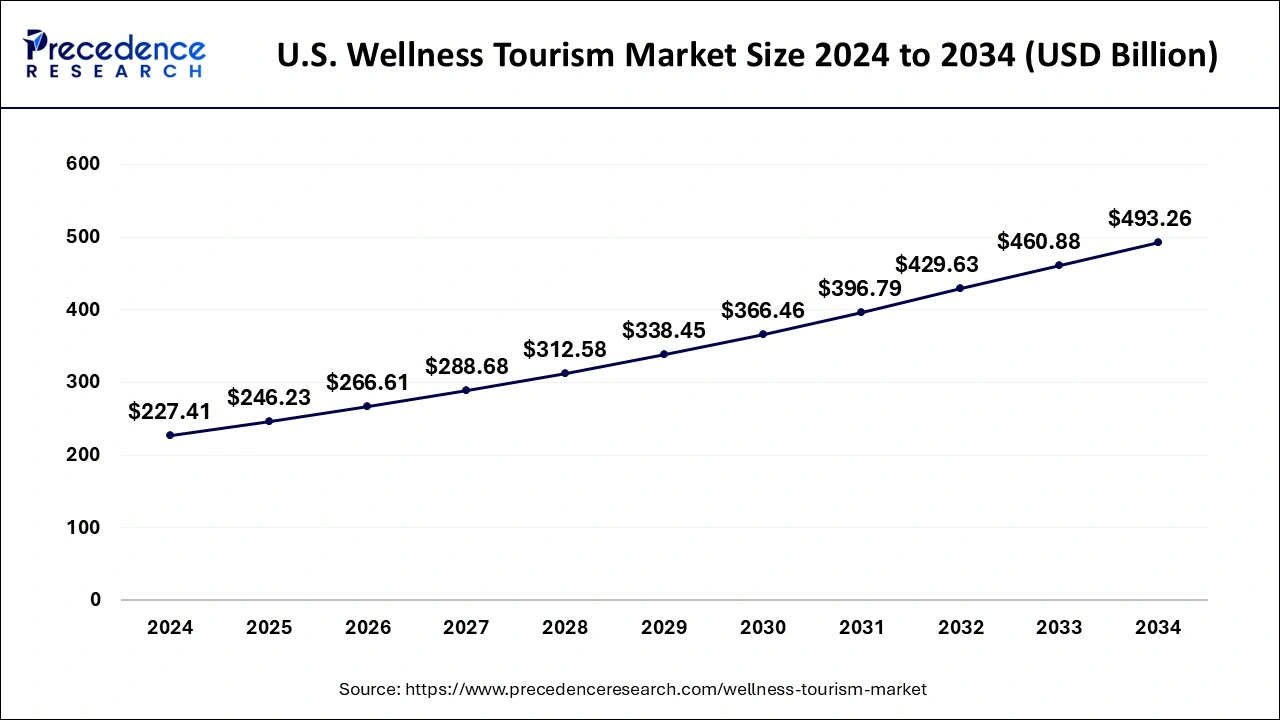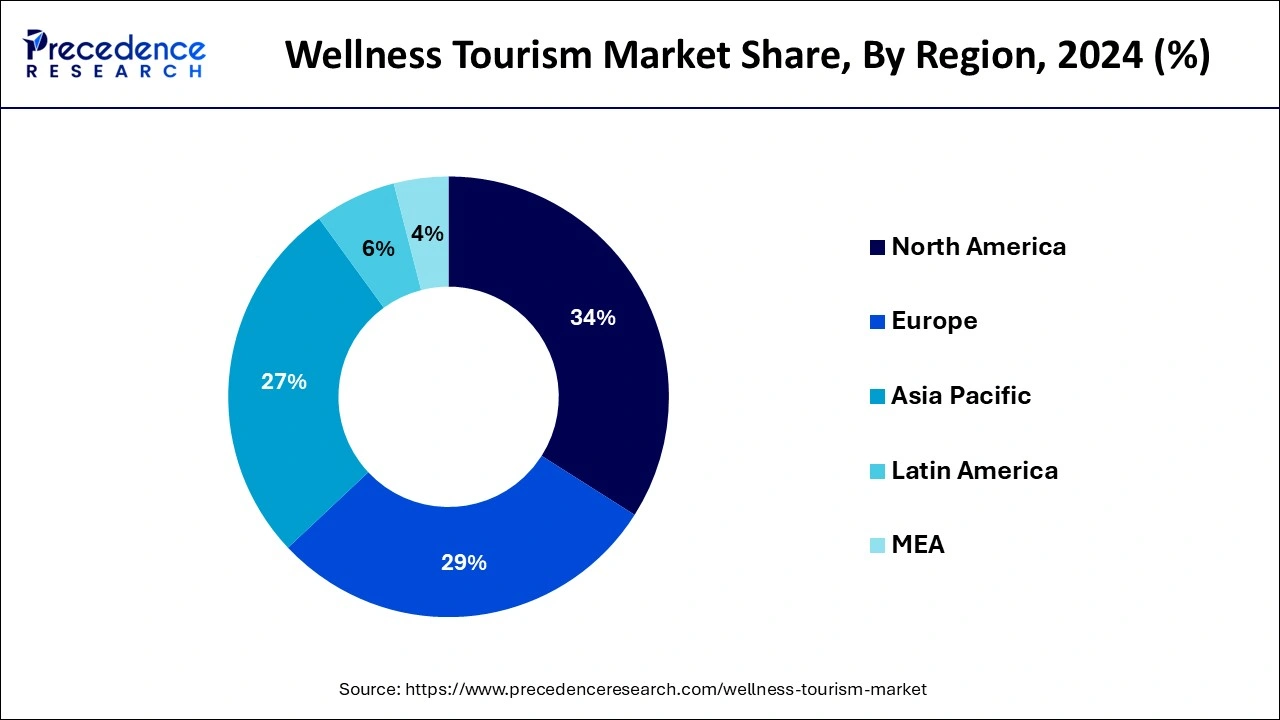List of Contents
What is Wellness Tourism Market Size?
The global wellness tourism market size is accounted for USD 1032.38 billion in 2025 and is predicted to reach around USD 2054.90 billion by 2035 growing at a CAGR of 7.79% from 2026 to 2035. The rising awareness for maintaining health and well-being, sedentary lifestyles, and rising disposable incomes drive the market.

Market Highlights
- North America led the global wellness tourism market with the largest market share of 34% in 2025.
- Asia-Pacific is observed to witness the fastest rate of growth during the forecast period.
- By service, the lodging segment held a dominant presence in the market in 2025.
- By service, the wellness activity segment is expected to grow at a significant rate during the forecast period.
- By destination, the domestic segment led the global market in 2025.
- By destination, the international segment is projected to expand rapidly in the market in the coming years.
- By traveler, the secondary segment held the largest share of the market in 2025.
Impact of AI on the Wellness Tourism Market?
The advent of advanced technologies, such as artificial intelligence (AI), machine learning (ML), and the Internet of Things (IoT) revolutionize the tourism sector. AI-enabled wearables and hyper-personalization in hospitality are the major advancements in wellness tourism. Several hotels and spas integrate AI and predictive analytics to get real-time data about guest needs and preferences. This enables hotels and spas to provide personalized amenities and offers to their customers. AI can also provide real-time tracking data about flights and trains to travelers. Additionally, AI can predict customized treatment options for patients based on their cultural preferences and moods. Hence, leveraging AI in wellness tourism can enhance patient experiences, streamline operations, and ensure optimal treatment outcomes.
Market Overview
Wellness tourism is a type of travel associated with the pursuit of maintaining or enhancing personal well-being. It is a part of the hospitality sector comprising health, fitness, spirituality, and travel. It offers various activities and treatments to nourish the human spirit and promote holistic well-being and health. Unlike traditional travel, wellness travel provides a wide range of services from destination well-being breaks with hot springs and aromatherapy massages to adventures focusing on self-development and introspection. The different types of wellness tourism include spa breaks, yoga retreats, meditation retreats, and healthy eating breaks. It offers numerous benefits including mental restoration, physical revitalization, cultural exchange, and social engagement.
Technological Advancement
Technological advancements in the wellness tourism market feature mobile applications, wearables, virtual yoga, and online booking and information. Mobile applications and wearables keep track of health, such as sleep cycle, heart rate, and other activities that calculate the overall health of the individual. These tools are primarily used by travelers and health-conscious individuals, indirectly benefiting the wellness tourism industry by encouraging its adoption or recommendation for a better user experience.
Online booking and information is the quickest digital platform to access details regarding the destination, activities, accommodation, and updates. Technological advancements have also encouraged yoga instructors to opt for virtual yoga classes and meditation. The wellness factor is successfully achieved due to the advancement and adaptive preferences options for both travelers and businesses. The technology is speeding up to promote health and adventure simultaneously, attracting new businesses to enter the wellness tourism market.
Wellness Tourism Market Growth Factors
- People living in developing and developed countries have sedentary lifestyles which increases their demand for healthy lifestyles.
- Rapid urbanization and expanding infrastructure, especially in developing countries, promote wellness tourism market growth.
- The rising disposable incomes increase the demand for wellness tourism.
- Advanced technologies are used for digital marketing by travel agents and tourism service providers, potentiating market growth.
- The rising adoption of the Internet increases awareness about wellness tourism, boosting the market growth.
- The burgeoning e-commerce sector leads to the online sales of tickets, eliminating the need to physically buy tickets.
- The rising incidences of mental illnesses such as depression and anxiety facilitate the wellness tourism market.
- The rapidly expanding tourism industry positively influences the market.
- Several government organizations develop policies to promote tourism in their respective countries.
- Wellness tourism can aid in reducing carbon footprint, promoting environmental sustainability.
Factors influencing the market
The wellness tourism market is highly influenced by various factors that augments the growth of the market. The various factors include growing awareness regarding wellness tourism, growing burden of disease, rising number of mental illness such as depression & anxiety, rising disposable income, growth of tourism industry, growing adoption of online travel services, increased influence of social media, and rising investment by the government to attract tourism.
Besides, these growth factors, there are certain factors that may hamper the growth of the wellness tourism market. The growing threat of terrorist invasion and political unrest may hamper the market growth. For instance, the recently a terrorist organization has taken over the political control in Afghanistan. These factors may destroy the tourism industry growth.
Market Scope
| Report Coverage | Details |
| Market Size in 2025 | USD 1032.38 Billion |
| Market Size in 2026 | USD 1117.03 Billion |
| Market Size by 2035 | USD 2185.40 Billion |
| Market Growth Rate from 2026 to 2035 | CAGR of 7.79% |
| Largest Market | North America |
| Base Year | 2025 |
| Forecast Period | 2026 to 2035 |
| Segments Covered | Service, Destination, Traveler, and Region |
| Regions Covered | North America, Europe, Asia-Pacific, Latin America, and Middle East & Africa |
Market Dynamics
Drivers
Rapidly Expanding Tourism Industry
The rapidly expanding tourism industry promotes wellness tourism market growth. The COVID-19 post-pandemic era has shown a surge in traveling among many people. McKinsey and Company predicted that domestic travel will grow 3% annually and reach 19 billion lodging nights per year by 2030. It is also estimated that international travel will surge to 9 million nights. Popular destinations for wellness tourism include Iceland, Thailand, India, and Costa Rica. Thus, the increasing number of tourists to these places promotes market growth. Governments also support tourism by building infrastructure and providing investments for expanding tourist places.
Restraint
High Cost and Language Barriers
The wellness tourism market faces formidable challenges, such as high costs and language barriers. High costs for flights, accommodation, transportation, food, and other travel-related costs hinder the market growth. Numerous low- and middle-income groups cannot afford such huge costs for health wellness. The language barrier is another major challenge as travelers find it difficult to communicate with foreign healthcare professionals and staff, restricting market growth.
Opportunity
Growing Demand for Good Health and Innovations
The future of the wellness tourism market is promising, driven by the growing demand for good health and the latest innovations. The increasing incidences of mental illnesses promote the demand for good health. According to the American Psychological Association 2024 survey, three-quarters of adults agreed to have increased stress levels over the past year. The demand for good health increases due to rising incidences of chronic disorders and the willingness to spend resources, including time, money, and energy. Moreover, the latest innovations driven by cutting-edge technologies, such as AI and augmented reality also present future growth opportunities for the market. These technologies are estimated to take center stage, emphasizing the commitment to providing consumers with immersive and engaging experiences in the realm of health and wellness.
Wellness Tourism MarketSegment Insights
Service Insights
The lodging segment led the global wellness tourism market with a remarkable revenue share in 2024 and is anticipated to retain its dominance throughout the forecast period. The hotel and lodges are one of the primary components of the tourism industry. The growing penetration of luxury and premium hotels in popular tourist destinations is a major contributor to the growth of the lodging segment.
On the other hand, wellness activity segment is anticipated to be the most opportunistic segment during the forecast period. This is attributed to the increased consumer expenditure on health and well-being. The various popular wellness activities include meditation, yoga, Ayurveda treatment, spa treatment, and agricultural tourism.
Destination Insights
The domestic segment led the global wellness tourism market with a remarkable revenue share in 2025 and is anticipated to retain its dominance throughout the forecast period. Domestic travelers find it simple to travel to domestic sights. Moreover, price-conscious travelers and low and middle-income groups generally avoid international tourism mainly due to financial limitations. Hence, domestic wellness tourism dominates the global wellness tourism market.
By destination, the international segment is projected to expand rapidly in the market in the coming years. The segment's growth is attributed to the rising disposable income, growing demand for international trips, and the growing number of high-income groups. The affordable flight prices also increase international travel. The rising awareness about tourism places in South-Asian countries like Malaysia, India, and Thailand propels the segment's growth.
Traveler Insights
By traveler, the secondary segment led the global wellness tourism market with remarkable revenue share in 2024 and is anticipated to retain its dominance throughout the forecast period. Secondary travelers include various wellness activities in their tourism activity while the main purpose of their travel is different. Generally, business travelers and leisure travelers include wellness activities in their tourism as they enjoy wellness activities and accomplishment of their main motive simultaneously.
Wellness Tourism Market Regional Insights
The U.S. wellness tourism market size is exhibited at USD 246.23 billion in 2025 and is expected to be worth around USD 524.89 billion by 2035, growing at a CAGR of 7.86% from 2026 to 2035.

North America led the global wellness tourism market with the largest market share of 34% in 2025. North America is dominating the wellness tourism market. The attractiveness of tourist places attracts travelers across the regions to visit for holidays and to relax mentally. Intelligently developed destinations work both for enjoyment and wellness. North America has an enriched development and well-maintained infrastructure of tourist spots. This attracts demand for this market.

Asia Pacific is forecasted to be the most opportunistic market in the forthcoming years. Growing infrastructure and high investment in improving connectivity is fueling the market growth in Asia Pacific. The growing penetration of luxury and premium hotels is another factor propelling the market growth. Moreover, rising personal disposable income, rising awareness regarding wellness tourism, and increasing penetration of digital technologies will shape the future of the wellness tourism market in Asia Pacific in the foreseeable future.
Wellness Tourism Market Companies
- Hilton Worldwide
- Accor Hotels
- Marriot International
- Hyatt Hotels
- Rosewood Hotels
- InterContinental Group
- Radisson Hospitality
- Rancho La Puerta, Inc.
- PRAVASSA
- Omni Hotels & Resorts
- Four Seasons Hotels
Latest Announcement by Industry Leaders
- Susie Ellis, Chair and CEO of Global Wellness Summit and Institute envisioned that global aging, rising chronic diseases, mental health concerns, growing consumer value in wellness, and technological innovations will drive the future of wellness tourism. She also emphasized that the pandemic heightened the importance of wellness.
Recent Developments
- In May 2025, Westin Resort and Spa Ubud promoted slower, more immersive wellness travel with a new extended-stay offer anchored in nature and local tradition. Westin Ubud is putting �slow wellness' in focus.
- In April 2025, Thailand expanded into the Middle East market, highlighting luxury and wellness tourism at the Arabian Travel Market 2025. The business expansion is a beneficial contribution to the wellness tourism market.
- In May 2025, Marriott and Hilton announced their plans to expand their spa presence across Asia in response to the region's rapid surge in wellness tourism, driven by rising disposable incomes, health-conscious travelers, and growing preference for holistic, preventive care.
- In December 2024, the Wellness Tourism Association recognized Antigua and Barbuda as its first wellness destination. The destination was selected based on the integration of wellness into a location's community and local economy to prioritize both physical and mental well-being.
- In September 2024, EaseMyTrip announced its entry into the rapidly growing wellness tourism sector through acquisitions of Pflege Home Healthcare and Rollins International with a total investment of Rs. 90 crores.
Wellness Tourism MarketSegments Covered in the Report
By Service
- Lodging
- Foo
- Transport
- Beverage
- Wellness activity
- Others
By Destination
- International
- Domestic
By Traveler
- Primary
- Secondary
By Region
- North America
- Latin America
- Europe
- Asia-pacific
- Middle and East Africa
For inquiries regarding discounts, bulk purchases, or customization requests, please contact us at sales@precedenceresearch.com
Frequently Asked Questions
Ask For Sample
No cookie-cutter, only authentic analysis – take the 1st step to become a Precedence Research client



